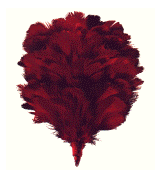This article needs additional citations for verification .(December 2013) |

The hackle is a clipped plume or short spray of coloured feathers that is attached to a military headdress, with different colours being associated with particular regiments. [1]
Contents
- British Army
- Hackle colours in British fusilier regiments
- Non-fusilier regiments
- Other armies
- Australian Army
- Canadian Army
- Dutch Army
- Indian Army
- Malaysian Army
- New Zealand Army
- Pakistan Army
- Sri Lanka Army
- South African Army
- Swedish Army
- United States Army
- References
In the British Army and the armies of some Commonwealth countries, the hackle is worn by some infantry regiments, especially those designated as fusilier regiments and those with Scottish and Northern Irish origins.
The modern hackle has its origins in a much longer plume, originally referred to by its Scots name, heckle, which was commonly attached to the feather bonnet worn by Highland regiments (now usually only worn by drummers, pipers and bandsmen). The smaller version originated in a regimental emblem adopted by the 42nd Royal Highland Regiment, to be worn in the sun helmet issued in hot-weather postings from the 1870s. [2]



